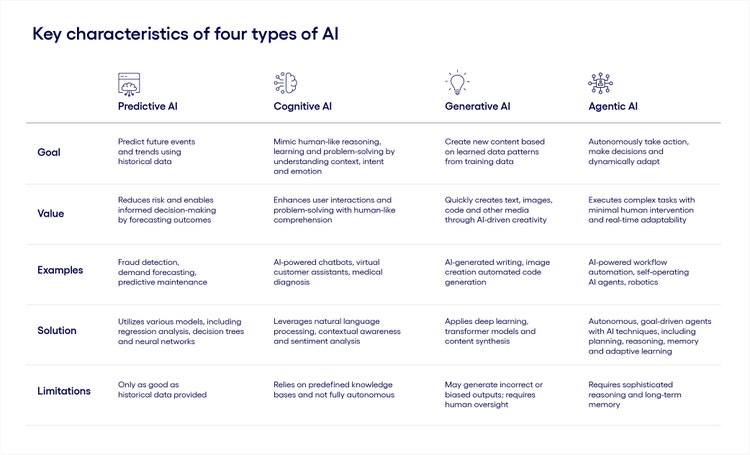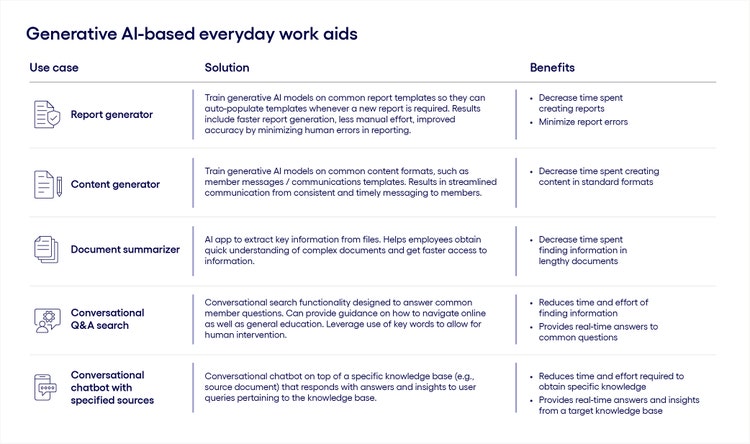<p><br> <span class="small">June 30, 2025</span></p>
A successful AI strategy starts with selecting the right type of AI
<p><b>Here are four types of AI available today and how businesses can select and integrate them to drive tangible outcomes.</b></p>
<p>Achieving high-value business outcomes from AI isn’t about the size of your budget. Instead, it’s about selecting the right AI solution to address your business challenge and leveraging it effectively.</p> <p>Choosing the wrong type of AI can lead to wasted resources, missed opportunities and even unintended negative outcomes. For instance, relying on a generative AI chatbot for customer service in a highly complex environment could negatively impact customers.</p> <p>On the other hand, by combining or layering different types of AI, such as predictive analytics or agentic AI to personalize customer interactions, businesses can create an effective solution tailored to their specific needs.</p> <p>This article explores four types of AI available today and how businesses can make the right decisions about selecting and integrating them to drive tangible outcomes.</p>
Why you need a strategic AI approach
Organizations that approach AI adoption without aligning it with their strategic goals risk missing out on its full potential. A well-structured AI strategy considers three foundational principles:
- Business objectives: Identifying which AI solutions align with key priorities (e.g., revenue growth, cost efficiency, customer engagement)
- Operational integration: Ensuring AI seamlessly fits into the existing business workflows and technology stacks
- Scalability and governance: Managing AI responsibly to avoid risks related to bias, security and regulatory compliance
Businesses that define these foundational principles will implement AI in a manner that enhances decision-making, improves productivity and fuels innovation.
<h4><span style="font-weight: normal;"><br> Four types of AI for AI transformation</span></h4> <p>AI is not a one-size-fits-all solution. The type of AI that businesses select is essential to any AI program’s success.</p> <p>The four main types of AI to consider for a strategic AI transformation include predictive AI, cognitive AI, generative AI and agentic AI. Each of these choices involves a distinct set of AI tools and capabilities, with each requiring a unique implementation approach. The below image provides a high-level definition of these different types of AI.</p>

#
<p><span class="small">Figure 1</span><br> </p> <h5><span style="font-weight: normal;"><span class="text-bold-italic">1</span>. Predictive AI: Enhancing decision-making</span></h5> <p>Predictive AI leverages historical data to identify patterns and forecast future outcomes. By applying machine learning models to vast datasets, businesses can anticipate demand shifts, optimize resources and mitigate risks before they materialize.</p> <p><b>Example: Detecting fraudulent pension contributions (pension spiking) using traditional machine learning models and predictive AI</b></p> <p>We worked with a pension organization to address the critical challenge of detecting anomalous or "spiked" pension contributions within large volumes of transaction data. Pension organizations often face significant financial risk due to irregular, one-off or suspiciously high contributions that may not align with historical patterns or regulatory guidelines.</p> <p>This challenge was a good fit for predictive AI as it can predict future events (spiking), given the historical (compensation) data.</p> <p>The system leverages a large learning model trained to distinguish between normal and spiked pension contributions. It ingests historical transaction data, captures relevant patterns (such as contribution frequency, amount deviations and contributor profiles) and flags outliers. The API framework ensures efficient, real-time inference and integration with existing pension management systems. Additionally, the system provides insights to the business on the impact of anomalies.</p> <p>Key advantages of the system include:</p> <ul> <li>Automatically detects spiked pension contributions</li> <li>Reduces the need for manual review</li> <li>Minimizes the risk of fraudulent or non-compliant transactions</li> <li>Enables decision-making with concise summaries and actionable insights of historical data</li> <li>Supports proactive risk management and strategic planning by delivering timely, relevant information about transaction anomalies.</li> </ul> <p>Potential applications include insurance, banking and payroll systems where contribution or payment spikes may indicate risk, fraud or compliance issues.</p> <h5><span style="font-weight: normal;"><span class="text-bold-italic">2</span>. Cognitive AI: Improving customer experience</span></h5> <p>Cognitive AI replicates human-like reasoning, enabling machines to understand context, process natural language and derive meaning from unstructured data. Such data can include corporate- and domain-specific knowledge bases, emails, retirement fund documents and social media posts. This form of AI is particularly valuable in customer service, knowledge management and personalization.</p> <p><b>Example: Streamlining customer service with retirement-fund Q&A bots</b></p> <p>In our work with a financial services organization, we leveraged a question-and-answer (Q&A) bot to support customer service teams. This bot contextualizes fund management documents and provides instant, reliable support for customer service staff.</p> <p>Because of the customer-facing nature of these interactions, and the resulting need for fast support—cognitive AI was the ideal solution for this bot. Agentic AI may have also been a possible solution; however, an agentic solution would have required many more resources to achieve the same outcome due to the ongoing decision-making of agentic AI vs. the repetitive nature of cognitive AI.</p> <p>This AI-powered bot streamlined the process of obtaining information such as investment options, plan rules and retirement strategies, making financial planning tools more accessible to customer service staff. These Q&A bots enabled portfolio managers and financial advisors to deliver a higher standard of service while optimizing their own workflows.</p> <p> Key advantages of this system include:</p> <ul> <li>Real-time, 24x7 support for questions regarding retirement plan options, contributions, withdrawals and tax</li> <li>Effective leverage of retirement, investment and regulatory documents</li> <li>Consistent, accurate information delivery, reducing confusion and errors in retirement planning</li> <li>Scalable support for a wide range of user queries without increasing operational costs</li> <li>Continuous learning from user interactions</li> <li>Improved quality and relevance of responses over time</li> </ul> <p>Q&A bots can be integrated into online management platforms, planning tools and customer support portals, helping both users and customer support staff navigate the complexities of financial planning and beyond.</p> <h5><span style="font-weight: normal;"><span class="text-bold-italic">3</span>. Generative AI: Driving innovation and productivity </span></h5> <p>Generative AI creates new content, ideas or solutions based on patterns learned from existing data. It can be applied in creative industries (content generation), scientific research (drug discovery) and manufacturing (product design).</p> <p><b>Example: Boosting employee productivity with generative AI-driven tools</b></p> <p>Because generative AI is extremely effective with generating new content, this type of AI is ideal for supporting employees and other internal stakeholders to work more efficiently.</p> <p>We used generative AI to develop “everyday work aids” for a financial services firm. While these were developed for a financial services organization, they are applicable across industries.</p>

#
<p><span class="small">Figure 2</span></p> <h5><span style="font-weight: normal;"><span class="text-bold-italic">4</span>. Agentic AI: Enhancing productivity through autonomous decision-making</span></h5> <p>Agentic AI, also known as autonomous AI, goes beyond pattern recognition and content generation—it actively makes decisions, takes actions and adapts to real-world changes with minimal human intervention. This is especially valuable in areas requiring real-time optimization and process automation.</p> <p><b>Example: Accelerating, evaluating and onboarding new technologies for a banking services organization</b></p> <p>We worked with a banking services group to streamline and automate the evaluation of technical debt and technology onboarding decisions within the organization. This was a good fit for agentic AI because we wanted the work to happen autonomously in the background without prompts or manual intervention. This accelerated the process of assessing technology requests and reduced reliance on subject matter expertise and subjective judgment.</p> <p>The core methodology leverages agentic AI as an intelligent agent to analyze technology requests, existing tech stacks and organizational needs. The system parses incoming requests, compares them with current capabilities, and determines whether new technologies should be onboard or whether existing solutions would suffice. This is achieved through automated document analysis, knowledge graph construction and contextual reasoning, all orchestrated with AI agents.</p> <p>Key benefits realized:</p> <ul> <li>Drastic reduction—up to 90% in time spent evaluating technical debt and technology onboarding decisions</li> <li>Significant reduction in manual errors by automating complex, repetitive evaluation tasks</li> <li>Lower operational costs associated with technology assessment and decision-making</li> <li>Improved consistency and traceability in technology governance processes</li> </ul> <p>Such a solution is highly valuable across industries with complex technological landscapes, including financial services, healthcare, telecommunications and large-scale enterprises where rapid, accurate technology evaluation is critical for innovation and compliance.</p> <h4>Unlock the full potential of strategic AI</h4> <p>The convergence of predictive AI, cognitive AI, generative AI and agentic AI is reshaping industries, offering businesses new opportunities to enhance decision-making, improve customer experience, drive innovation and automate workflows.</p> <p>However, realizing AI’s full potential requires more than just implementing technology—it demands a strategic, enterprise-wide approach that aligns AI investments with business goals, integrates seamlessly into existing operations, and ensures responsible, scalable adoption.</p> <p><i>The future of business is AI-powered. Let’s build it together. Contact </i><a href="https://www.cognizant.com/us/en/services/consulting" target="_blank"><i>Cognizant Technology Consulting</i></a><i> to explore how we can help you design and implement an AI strategy tailored to your needs.<br> </i></p>
<p>Christie Apodaca is a Consulting Principle within Cognizant’s CIO Advisory practice. She has over 12 years of experience working with business and technology leaders to drive high-value business outcomes from technical solutions. Her work spans technology strategy, platform modernization and cost optimization, helping clients make technology decisions across industries.</p>
<p>Venkata Popuri is an Associate Partner in the AI growth team at Cognizant, with 25 years of experience in IT. Venkata specializes in creating scalable, high-performance and cost-effective solutions for customers, focusing on machine learning, generative AI and cloud-native solutions on AWS and Azure platforms.</p>



